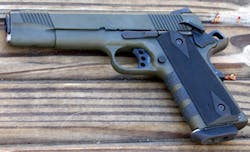Well, it's been another fourteen months and another 2,500 rounds (give or take one or two). As promised in the last update, when I reached 10,000 rounds I'm providing a new report. As I type this there is a part of me that wonders if the gun suffers any from the fact that it is essentially my on-going T&E tool for everything .45ACP. Ammo, grips, sights, and every other after-market do-witchy gadget gets tested on this weapon. So far it hasn't missed a beat. At the 10,000 round mark, reached on August 17th, 2008, the gun was still shooting 7-shot one-hole groups from 21 feet free hand. You gotta love it.
When I first purchased the Springfield Armory "loaded" .45ACP (Model #PX9609L) with an OD Green finish I was impressed with the fit and finish. The only things I didn't really care for on the weapon - although they were still functional - was the rubber grip slabs and the slick front strap. My answer to the slick front strap was a piece of adhesive material made by Tac-Grip. Tac-Grip makes excellent adhesive grip slabs for many weapons and the center piece of a set of their precut grip panels was exactly what I needed.
I replaced the grip slabs with a set of black slabs made of G10 from Mil-Tac. Made of the same material many knife grips are manufactured from, the slabs offer a very textured surface and are durable enough to prevent much wear. They have proven easy to hold and provide good control even when wet with sweat or rain.
The standard sights on the weapon were fine but I prefer 24/7 Standard Dot sights from XS Sights. The rear sight is described as a "shallow V" and has a vertical insert for low light viewing. The front dot is a glowing dot inside a white circle. In the light or dark you just "dot the I". They were designed to get fast sight alignment on an aggressive target and I've been happy with them. All those modifications are in place in the top photo.
The final piece of this puzzle is the carry kit. I have a collection of holsters I typically carry my SA 1911 in ranging from custom made exotic leather by George Wells (Alligator leather with matching pouch and belt) to carbon fiber CQC holsters from BLACKHAWK!. More often than not for concealed carry I use the leather while for open carry and on the range I use the CQC holsters.
Now with all that out of the way, let's get down to the nitty gritty - or actually, the bullets down range. When I first purchased the gun, fresh from the box after a few magazines of "break in" shooting and using Winchester 230g FMJ ball ammo I was able to put a 14-shot group (two magazines full) into a single ragged hole measuring roughly 2" around from the 15 yard line. On my test date when I knew I was going to hit the 10,000 round mark I set up a target and was firing from the 7 yard line.
I started using a target a fellow instructor made available that he'd received from the Secret Service. It consists of a yellow stripe between two gray boxes and is intended to help assess student sight alignment / sight picture. In the 2nd photo you can see the results of the 50 rounds I fired on that target at ranges from 7 yards to 25 yards. At the 7 yard line when I scored my first hit in the yellow stripe (although I'll admit it wasn't my first shot because I slapped the trigger a bit) I aimed all follow-on shots at the hole. What resulted is that ragged hole in the lower half of the yellow line. Take a careful look at that picture and you can see between 7 and 9 distinct bullet holes that are NOT part of that ragged group hole in the middle. That means that at least 40 other rounds went through that one group hole.
The 3rd photo shows the head and small target section of that B27 above it. There are two things to note here that I kind of like:
- The little target: count those holes and you'll find 8. My fellow instructor, who I don't name here only because I didn't get his permission to, fired a magazine of ball ammo at the little target. He had never before handled a 1911-style pistol (his police agency was all Beretta and then Glock) and commented on the weight of the weapon. He had never before fired a single action only weapon (unless you count Glocks that way) and wasn't familiar with the mechanical characteristics of the weapon, i.e. thumb lock, grip safety, slide stop. Still, at 7 yards, he put that magazine in a respectable grouping.
- On the head of the B27 you can see four distinct bullet holes and then one group hole. The two marked holes high right and low were called flyers by the author. The remaining two holes and that ragged group hole represent the other 12 rounds fired from the 15 yard line using a barricade for support. That's 10 rounds in that group hole.
The gun still shoots!
So, after 10K rounds what else need I worry about? Wear and tear. With the pistol clean and assembled there are no signs of wear on the OD Green Armory Coat finish that Springfield Armory applied. When I had the weapon in the "early years" (for this pistol) I had replaced the ambi-safety with a single-sided one but then didn't like it and switched it back. As a result there are a few scratch marks on the left side of the safety where I grabbed it with plyers (hey, I'm not a gunsmith). Other than that, four years and 10K rounds later, there are no wear marks from holstrs or scratches from being dropped, etc. It holds up well.
Field stripping it and then detail stripping the slide I looked at the firing pin - still in great shape and the extractor. Without the proper measuring equipment I can't tell whether or not the ejector's face and claw have worn any. They don't appear to and obviously still function with no problems. The breach face is still smooth (or as smooth as it's ever been) and the only marks I can find on the slide are on inner surfaces where it rubs against the frame. These are minor and expected.
The barrel, once cleaned, shows no signs of wear at all. All inner and outer surfaces - as best I can examine with the naked eye - look just like they did when I first bought it. The swivel and pin are still snug and move smoothly. The feed ramp shines just as beautifully as it did before I loaded the weapon the first time. The frame looks in equally good shape. It's not been dropped or banged around much so there hasn't been much chance for it to get dinged up. The slide rails show the signs of wear you'd expect but, other than that, it looks new.
So, 10,000 rounds later I can say that:
- The weapon still performs well. I consider a more-than-worthy investment, and
- I look forward to seeing how it does with another 10K rounds!
I will update the status at the 15,000 round mark which, at my current rate of range time and bullet consumption, will be sometime in 2010. Stick around!
Stay Safe!



